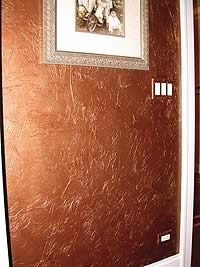
…continued from previous page
A Look at Metallic Paints
Although decorative painters are only recently turning to metallics in large numbers, creating pigments from metal flakes has been done since the Bronze Age
by Christina Camara
Since the painting contractor can choose the medium he wants to use with the powders, he then can also control the unique patina and other effects created. Powders give the most possible control over the end result.
Professional artist Douglas Coggeshall of Hinsdale, Ill., who specializes in faux finishes, grisaille and trompe l’oeil, uses Crescent Bronze Powder Co.’s metallics exclusively. The company’s Cres-Lite line of primers, mixing clears and ready-mixed paints comes in 111 colors and has been used in Chicago’s Cadillac Theater, The MGM Grand in Las Vegas and the Ritz Carlton Hotels.
Goldtone No. 12 is one of Coggeshall’s favorites. “It’s as close to gold leaf as you can get without actually putting down gold leaf products,” he says. In fact, the color is so close that he uses it for small touch-ups on 24-carat gold leaf projects.
Coggeshall has used metallics to produce unusual effects. In a mural he painted of the French countryside, he created twinkling stars and candlelit windows by mixing a phosphorescent color with a latex glazing medium. He used metallics to create a warm and inviting bronze and copper living room. He produced a crinkle effect by sticking torn and crumpled tissue paper to the wall with heavy-duty wallpaper paste, then layering on the colors.
He uses metallics most often to give a room a touch of elegance — gold on a ceiling medallion or a pinstripe on a chair rail or a recessed ceiling. He advises his clients to use restraint for a more tasteful look. “Any metallic is going to draw your attention,” he says, “so I tell my clients that less is more.” It’s easy to take metallics too far. “It’s fun because you put it down and it’s breath-taking, but before you know it, it’s way over the top.”
Another way to create a metallic look is to use ready-made metallic paints. The mixing is already done. No special skills are needed, and simply substituting metallic paint for latex can give a room a shimmering glow in a range of colors you won’t find on a standard color wheel.
Monte Lazarus, president of Crescent Bronze Powder Co., says it’s now possible to create a metallic silver, gold or copper wall using a latex that can be cleaned up with soap and water. “If you want to use our metallic paints, they’re made to a formula,” he says. “You open the can, stir it up and use it.” Chromatone, the company’s water-based metallic paint, can be used in an endless range of applications, including picture frames, statues, hand rails, light fixtures, lamps, furniture and gilding, or to create faux finish effects on walls and other surfaces. Chromatone comes in six ready-mixed colors: silver, pale gold, rich gold (brass), copper, roman gold and the newest color, oyster-pearl.
“Many people find oyster-pearl to be the perfect accent for other colors,” Lazarus says, “and it can also be used as a base and tinted to produce pearl finishes in every color of the rainbow.”
 If you’re looking for a shiny, metallic finish, spraying will produce the most uniform effect, although brushing and rolling can be done too. Lazarus says to make sure the paint doesn’t overlap — don’t brush or roll in two directions, up and down and then across. Always prime the area to be painted. Heavily used areas, such as banisters that will be touched often, should be protected with a topcoat. If you’re looking for a shiny, metallic finish, spraying will produce the most uniform effect, although brushing and rolling can be done too. Lazarus says to make sure the paint doesn’t overlap — don’t brush or roll in two directions, up and down and then across. Always prime the area to be painted. Heavily used areas, such as banisters that will be touched often, should be protected with a topcoat.
Using a roller with metallics is not the best option because the paint tends to show roller lines, creating an orange-peel effect that’s not desirable, Cody says. If a roller is used, the shorter the nap the better. Adding an extender into the metallic paint can make it a little wetter, creating a more even surface. Pushing a stipple brush onto the painted surface will eliminate any brush or roller lines and leave no hint that any tool was used.
Decorative painters and manufacturers all have their favorite effects. Neuberg says metallic powders can be mixed into a glaze, then applied with a sponge or rag to a painted wall to give it a glittery look. Cody says he likes a distressed effect, with just enough patina to age it and a coating of wax to make it look truly lived in. Another great look involves a Venetian plaster material that has a metallic base color, say a brown ochre or steel gray. Mixing a metallic powder into a thicker medium and washing it over the plaster will give the project a subtlety and richness of color that varies depending on how heavily it was applied, Cody says.
Understanding metallic products, experimenting with powders, paints and techniques, and then practicing over and over can give decorative painters a new creative focus. Layered textures, depth of color, shimmering light — these effects are attracting more customers and painting contractors to the world of metallics. As Neuberg puts it, “There’s basically no limit.”

|

